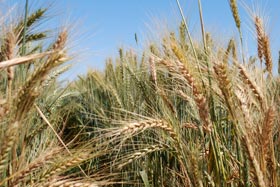CIMMYT E-News, vol 6 no. 6, October 2009
 In 2009, out of a global population of 6.8 billion people, more than 1 billion regularly woke up and went to bed hungry. By 2050 the population is expected to grow to 9.1 billion people, most of whom will be in developing countries. Unless we can increase global food production by 70%, the number of chronically hungry will continue to swell. To help ensure global food security, a new research consortium aims to boost yields of wheat—a major staple food crop.
In 2009, out of a global population of 6.8 billion people, more than 1 billion regularly woke up and went to bed hungry. By 2050 the population is expected to grow to 9.1 billion people, most of whom will be in developing countries. Unless we can increase global food production by 70%, the number of chronically hungry will continue to swell. To help ensure global food security, a new research consortium aims to boost yields of wheat—a major staple food crop.
There is no easy fix for world hunger. Any improvement will require complex collaborative efforts and funding to support them. With this in mind, wheat scientists and agricultural experts from diverse private and public institutions are joining to form a Wheat Yield Potential Consortium (WYC). This group will strive to improve wheat yields, which must increase 1.6% annually to meet a projected demand of 760 million tons by 2020.
The unofficial launch of the WYC happened in November 2009, when over 60 world-renowned experts gathered for a USAID-sponsored symposium at CIMMYT’s Mexico headquarters to integrate various research components into a common breeding platform for improving wheat yields.
“Over the past year we’ve been pulling together experts in photosynthesis who have ideas on how to raise the overall biomass of the crop, as well as other experts in crop adaptation to make sure that increased biomass will also translate into better yields,” says Matthew Reynolds wheat physiologist and initiator of the WYC.
In recent decades, wheat yields have increased nearly 1% each year, but global population is growing roughly 1.5% annually. Climate change, unsustainable cropping practices, and changes in diet preferences further challenge wheat’s ability to meet the demands of a global population that relies on the crop for more than one-fifth of its caloric intake.
Meeting of the minds
“The international wheat community recognizes that each of us has different skills and that, though individually we cannot solve the problem of insufficient wheat yields, collectively we can,” said Richard Richards chief research scientist at Australia’s Commonwealth Scientific and Industrial Research Organization, Plant Industry, who has been commissioned to review a WYC project proposal under development.
The Consortium will pursue advanced approaches to increase wheat yields, including increasing the efficiency of photosynthesis, improving the plant’s adaption to target environments, and using physiological and molecular breeding. To date, selective, conventional breeding has been the main force behind yield improvement. Scientists breed a large number of high-yielding wheat plants, select early generations with good agronomic traits, populate trial fields with the offspring, and move the best forward in the breeding program. The cycle is then repeated. This system has been successful, but precedent suggests it will not be fast enough to overcome the combined challenges of population growth and climate change. “Instead of going straight to the end product —yield—we must look at every yield-determining physiological process and improve the efficiency of the limiting ones,” Richards said.
Powering up photosynthesis
Under favorable conditions, yield is a function of the interception, conversion, and distribution of solar energy. To increase yield, one or more of these components must be improved. Thanks to years of wheat improvement, the efficiency of solar energy intercepted is nearly 90% and energy distribution results in an almost optimal proportion of total biomass to grain, roughly 50%. “This leaves the conversion of sunlight into chemical energy—mainly controlled by photosynthesis—as the main yield component left to improve,” said Xinguang Zhu, group leader of Plant Systems Biology at the CAS-MPG Partner Institute of Computational Biology.
One way to do this is to increase carbon-fixing efficiency during photosynthesis. Plants that thrive at moderate temperatures, like wheat, tend to use C3 carbon fixation, a slow system that accepts both carbon dioxide and oxygen. The fixation of oxygen, called photorespiration, reduces the efficiency of photosynthesis. Plants that inhabit warmer locations, like maize, tend to use C4 carbon fixation, which increases chloroplastic CO2 concentration, reduces photorespiration, and improves energy-use efficiency.
The fact that the C4 system has evolved many times in nature has inspired scientists to look for ways to introduce parts of it into wheat, so that the plant can thrive at relatively high temperatures. This will be essential as temperatures in tropic and subtropic regions continue to climb. Studies show that for every 1°C of warming, wheat yields in these areas will fall 10%. Given that 95% of the world’s malnourished people live in these regions—which also have the highest rates of population growth—high-yielding wheat that can beat the heat could make a world of a difference.
For more information: Matthew Reynolds, wheat physiologist (m.reynolds@cgiar.org).
 Capacity development
Capacity development